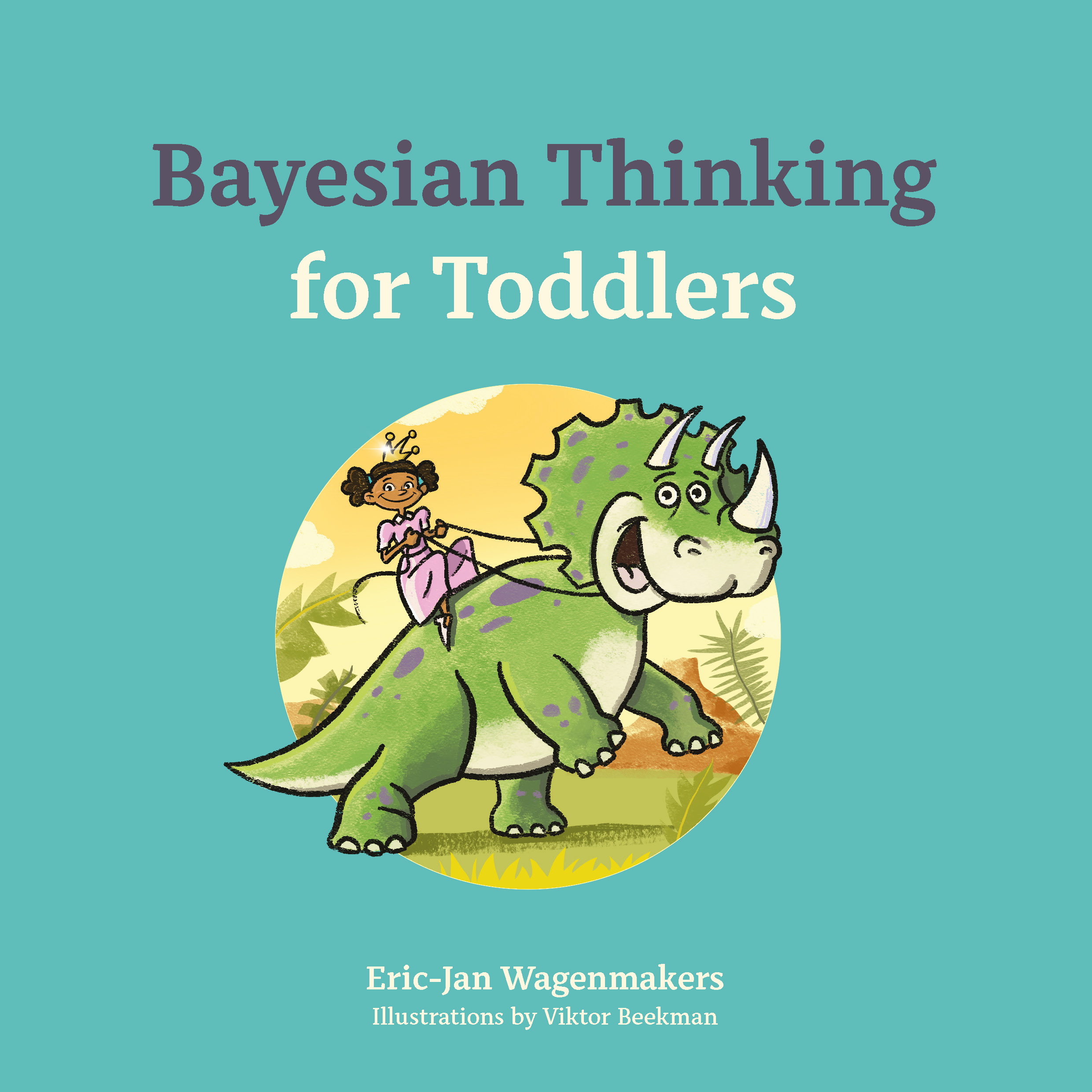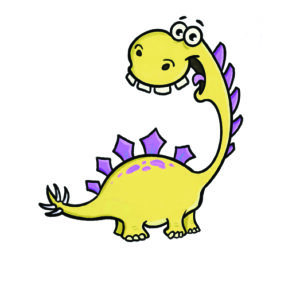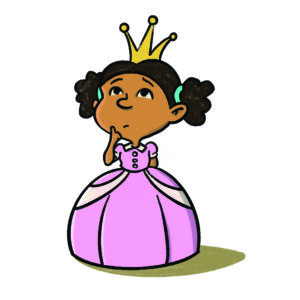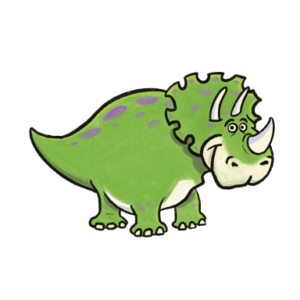
Eric-Jan Wagenmakers is a professor in neurocognitive modelling at UvA’s Psychological Methods Department. He recently published a book with the remarkable title Bayesian Thinking for Toddlers. Spiegeloog talked to him about the development, goals and target audience of the book.

How exactly did Bayesian Thinking for Toddlers come into existence?
‘A lot of what I do relates to promoting and explaining the benefits of Bayesian inference. At some point, I came across the book Bayesian Probability for Babies. When reviewing this book, I found myself disagreeing with some of its points. Some concepts weren’t properly explained and, as my young son pointed out, it didn’t have any dinosaurs.
 My former PhD student, Don van Ravenzwaaij, then challenged me by saying that I won’t be able to explain Bayesian statistics using dinosaurs. Together, these were the factors that started my work on what would become Bayesian Thinking for Toddlers. I worked on the book for about a year and collaborated with Viktor Beekman, an artist. This led to this book as a final result.
My former PhD student, Don van Ravenzwaaij, then challenged me by saying that I won’t be able to explain Bayesian statistics using dinosaurs. Together, these were the factors that started my work on what would become Bayesian Thinking for Toddlers. I worked on the book for about a year and collaborated with Viktor Beekman, an artist. This led to this book as a final result.
So, the book is the result of a challenge, but it also relates to my drive to explain Bayesian inferences as clearly as I can, to as many people as possible. The title suggests that the book is for toddlers, but in a way that is not really true. Toddlers can look at the colourful pictures, but the actual ideas in the book are quite deep. It can be compared it to an onion; you can go down as many layers as you would like. In that way there is something to take away from the book for everyone. Even a well-trained statistician would find a lot of topics for discussion in this book with dinosaurs.’
Do you think toddlers would still learn something if you would read the book to them?
‘Well, that is debatable. The main point I’m trying to make is that the core principle of Bayesian statistics is so obvious that even toddlers can understand it. They can understand that in a competition with questions and cookies as prize, if someone out-predicts somebody else, they will get more cookies. I also do think that if there is a prize, people often give 100 percent to the winner, which might not always be the most rational thing to do. If you know the results are very close, maybe you should just divide the prize. In the case that there is an element of noise or uncertainty involved in determining the winner. If this isn’t the case, the person who ends up winning should just get the whole prize. But, quite often we have substantial uncertainty.
 I do think toddlers like the book, because the pictures are very colourful, and the dinosaurs look very friendly. Toddlers are into dinosaurs and pictures of animals in general, so I think they will be drawn into the book. As they get older, they might get more and more out of the book. At some point, when we talk about the prequential principle, or the usefulness of predictions to update your knowledge, you get to topics where even philosophers would possibly disagree with some of the content in the book. So, I do think there’s something to learn in it for everybody.’
I do think toddlers like the book, because the pictures are very colourful, and the dinosaurs look very friendly. Toddlers are into dinosaurs and pictures of animals in general, so I think they will be drawn into the book. As they get older, they might get more and more out of the book. At some point, when we talk about the prequential principle, or the usefulness of predictions to update your knowledge, you get to topics where even philosophers would possibly disagree with some of the content in the book. So, I do think there’s something to learn in it for everybody.’
So, the book is not just an answer to a challenge. You’re also really trying to teach something?
‘Yes. The book says ‘Bayesian Thinking for Toddlers’, but that’s actually the least important goal of the enterprise. I would say explaining Bayesian thinking clearly or explaining how you update knowledge describes the content better. In a way it’s like these books ‘statistics for idiots or dummies’. You can say a book is for ‘idiots’, ‘dummies’ or ‘toddlers’, but you don’t really mean that. With such a title, you mean that you explain concepts clearly, without technical, difficult terms that can distract from the main message. That’s what I tried to do.
I could have done what the standard Bayesian statistician does, starting with an example that you toss a bent coin and then ask for the probability that it comes up tails. You start with a prior distribution and end up with a posterior distribution. But that immediately creates questions like ‘What do you mean with a prior distribution?’ Potentially, the probability of the coin falling on tails could be anything from zero to one. This introduces the concept of infinity, which on itself could be a whole book. ‘The Concept of Infinity for Toddlers’, which would be even more difficult to write than the book I wrote.
 The difficulty with these kinds of books – or with explaining anything clearly – is that it is very difficult for an expert to clearly explain the concepts they know. They are very knowledgeable on these specific concepts, which appear crystal clear to them, so they don’t fully explain them. They may assume that their audience has a basic level of knowledge on this matter, but this is often not the case. The way I tried to tackle that, is to leave out as much as I can and focus on the bare bone essentials.
The difficulty with these kinds of books – or with explaining anything clearly – is that it is very difficult for an expert to clearly explain the concepts they know. They are very knowledgeable on these specific concepts, which appear crystal clear to them, so they don’t fully explain them. They may assume that their audience has a basic level of knowledge on this matter, but this is often not the case. The way I tried to tackle that, is to leave out as much as I can and focus on the bare bone essentials.
In general, what people will hopefully take away from the book is that when you collect more information, the credibility of competing hypotheses changes. Another main principle that the book illustrates, is Ockham’s razor. The child that ends up winning a particular round, wins because it knows something precisely. In a way, simple, accurate hypotheses win over the complex ones. So, parsimony is rewarded.
I’m also planning to do a blog post that explains my reasoning and the examples I chose. Clearly, the information on the back cover is only for parents that are statisticians. Even then, a lot of statisticians wouldn’t know the prequential principle. Maybe one percent would give you the right answer when asked about it? Maybe less actually.’
Currently, the book is published online, are you also looking into ways to get it printed on paper?
‘I self-published about two hundred paper copies. I do think the printed version adds a lot over the pdf-file, but I published the book online so everyone can access it. I didn’t want to go to a regular publisher, as they tend to make the book overly expensive. I want many people to read it, but I don’t want to make it expensive. I dislike having people pay for knowledge and I get a salary from the university anyway. So, there are good moral arguments for not charging anything for the book. I’m not completely adverse to working with a publisher, as long as we can agree on a reasonable price. For now, I have taken zero efforts to contact any publishers.
 At the end of the book I added some advertisement for JASP, the statistical software we are developing here at UvA. I decided it could be part of the merchandise products we have for that software. That’s what I’m doing now.
At the end of the book I added some advertisement for JASP, the statistical software we are developing here at UvA. I decided it could be part of the merchandise products we have for that software. That’s what I’m doing now.
The book is also being translated into a lot of different languages, partly since there is very little text to translate. A Dutch version of the book is now available online as well.’
Have you read the book to your own children?
‘Yes, I have. In my experience children – or at least my children – like the book, up until the point that it becomes clear that it involves some kind of calculation. Then their eyes just glaze over. Children have very short attention span. My former PhD student has a child as well. This child was really into the other statistics book for babies. So, my former student did a test to see whether the child would prefer that book or my dinosaur book. The child preferred the dinosaur book, three days in a row! Of course, there could be lots of different explanations for this, but at least one child preferred my book over her favourite book up to that point. So that is a small success. ‘
Bayesian Thinking for Toddlers can be found online in both English and Dutch – and hopefully in more languages soon!

How exactly did Bayesian Thinking for Toddlers come into existence?
‘A lot of what I do relates to promoting and explaining the benefits of Bayesian inference. At some point, I came across the book Bayesian Probability for Babies. When reviewing this book, I found myself disagreeing with some of its points. Some concepts weren’t properly explained and, as my young son pointed out, it didn’t have any dinosaurs.
My former PhD student, Don van Ravenzwaaij, then challenged me by saying that I won’t be able to explain Bayesian statistics using dinosaurs. Together, these were the factors that started my work on what would become Bayesian Thinking for Toddlers. I worked on the book for about a year and collaborated with Viktor Beekman, an artist. This led to this book as a final result.
So, the book is the result of a challenge, but it also relates to my drive to explain Bayesian inferences as clearly as I can, to as many people as possible. The title suggests that the book is for toddlers, but in a way that is not really true. Toddlers can look at the colourful pictures, but the actual ideas in the book are quite deep. It can be compared it to an onion; you can go down as many layers as you would like. In that way there is something to take away from the book for everyone. Even a well-trained statistician would find a lot of topics for discussion in this book with dinosaurs.’
Do you think toddlers would still learn something if you would read the book to them?
‘Well, that is debatable. The main point I’m trying to make is that the core principle of Bayesian statistics is so obvious that even toddlers can understand it. They can understand that in a competition with questions and cookies as prize, if someone out-predicts somebody else, they will get more cookies. I also do think that if there is a prize, people often give 100 percent to the winner, which might not always be the most rational thing to do. If you know the results are very close, maybe you should just divide the prize. In the case that there is an element of noise or uncertainty involved in determining the winner. If this isn’t the case, the person who ends up winning should just get the whole prize. But, quite often we have substantial uncertainty.
I do think toddlers like the book, because the pictures are very colourful, and the dinosaurs look very friendly. Toddlers are into dinosaurs and pictures of animals in general, so I think they will be drawn into the book. As they get older, they might get more and more out of the book. At some point, when we talk about the prequential principle, or the usefulness of predictions to update your knowledge, you get to topics where even philosophers would possibly disagree with some of the content in the book. So, I do think there’s something to learn in it for everybody.’
So, the book is not just an answer to a challenge. You’re also really trying to teach something?
‘Yes. The book says ‘Bayesian Thinking for Toddlers’, but that’s actually the least important goal of the enterprise. I would say explaining Bayesian thinking clearly or explaining how you update knowledge describes the content better. In a way it’s like these books ‘statistics for idiots or dummies’. You can say a book is for ‘idiots’, ‘dummies’ or ‘toddlers’, but you don’t really mean that. With such a title, you mean that you explain concepts clearly, without technical, difficult terms that can distract from the main message. That’s what I tried to do.
I could have done what the standard Bayesian statistician does, starting with an example that you toss a bent coin and then ask for the probability that it comes up tails. You start with a prior distribution and end up with a posterior distribution. But that immediately creates questions like ‘What do you mean with a prior distribution?’ Potentially, the probability of the coin falling on tails could be anything from zero to one. This introduces the concept of infinity, which on itself could be a whole book. ‘The Concept of Infinity for Toddlers’, which would be even more difficult to write than the book I wrote.
The difficulty with these kinds of books – or with explaining anything clearly – is that it is very difficult for an expert to clearly explain the concepts they know. They are very knowledgeable on these specific concepts, which appear crystal clear to them, so they don’t fully explain them. They may assume that their audience has a basic level of knowledge on this matter, but this is often not the case. The way I tried to tackle that, is to leave out as much as I can and focus on the bare bone essentials.
In general, what people will hopefully take away from the book is that when you collect more information, the credibility of competing hypotheses changes. Another main principle that the book illustrates, is Ockham’s razor. The child that ends up winning a particular round, wins because it knows something precisely. In a way, simple, accurate hypotheses win over the complex ones. So, parsimony is rewarded.
I’m also planning to do a blog post that explains my reasoning and the examples I chose. Clearly, the information on the back cover is only for parents that are statisticians. Even then, a lot of statisticians wouldn’t know the prequential principle. Maybe one percent would give you the right answer when asked about it? Maybe less actually.’
Currently, the book is published online, are you also looking into ways to get it printed on paper?
‘I self-published about two hundred paper copies. I do think the printed version adds a lot over the pdf-file, but I published the book online so everyone can access it. I didn’t want to go to a regular publisher, as they tend to make the book overly expensive. I want many people to read it, but I don’t want to make it expensive. I dislike having people pay for knowledge and I get a salary from the university anyway. So, there are good moral arguments for not charging anything for the book. I’m not completely adverse to working with a publisher, as long as we can agree on a reasonable price. For now, I have taken zero efforts to contact any publishers.
At the end of the book I added some advertisement for JASP, the statistical software we are developing here at UvA. I decided it could be part of the merchandise products we have for that software. That’s what I’m doing now.
The book is also being translated into a lot of different languages, partly since there is very little text to translate. A Dutch version of the book is now available online as well.’
Have you read the book to your own children?
‘Yes, I have. In my experience children – or at least my children – like the book, up until the point that it becomes clear that it involves some kind of calculation. Then their eyes just glaze over. Children have very short attention span. My former PhD student has a child as well. This child was really into the other statistics book for babies. So, my former student did a test to see whether the child would prefer that book or my dinosaur book. The child preferred the dinosaur book, three days in a row! Of course, there could be lots of different explanations for this, but at least one child preferred my book over her favourite book up to that point. So that is a small success. ‘
Bayesian Thinking for Toddlers can be found online in both English and Dutch – and hopefully in more languages soon!



